Eugène Delacroix in 10 Paintings: Poetry, Passion, and Power
Early 19th-century French art was a battle between cool, crisp, precisely observed Neoclassicism and Romanticism’s passion for emotion, drama,...
Catriona Miller 3 July 2024
Francisco Goya’s work is well-known as dark and pessimistic. This reaction to his work is not uncommon, mostly due to the circumstances of his life and the political upheavals he experienced. However, before Spain fell to Napoleon, Goya worked as a court painter creating beautiful tapestry cartoons illustrating hope and everyday life in Spain. Here is a list of Goya’s 63 tapestry cartoons explained through seven series of works.
Considered one of the most important Spanish artists of the late 18th century, Francisco Goya’s work impacted art for the next 200 years. He was born on March 30th, 1746, and is known today as a Spanish romantic painter. At around 30, he became a court painter to the Spanish crown, one of the highest positions for a painter to receive. However, his life wasn’t easy. He lived through the Enlightenment in Spain and experienced the end of the Spanish Inquisition, which ultimately stemmed from the Napoleonic Wars.
When Napoleon invaded Spain in 1807, Goya lived in Madrid and worked for the Spanish court through the Royal Tapestry Factory. He had been at the court for a few decades by that point. From 1775 until 1791, Goya made 63 tapestry cartoons for the Spanish court. But why were 63 large tapestry cartoons commissioned, and what did they illustrate?
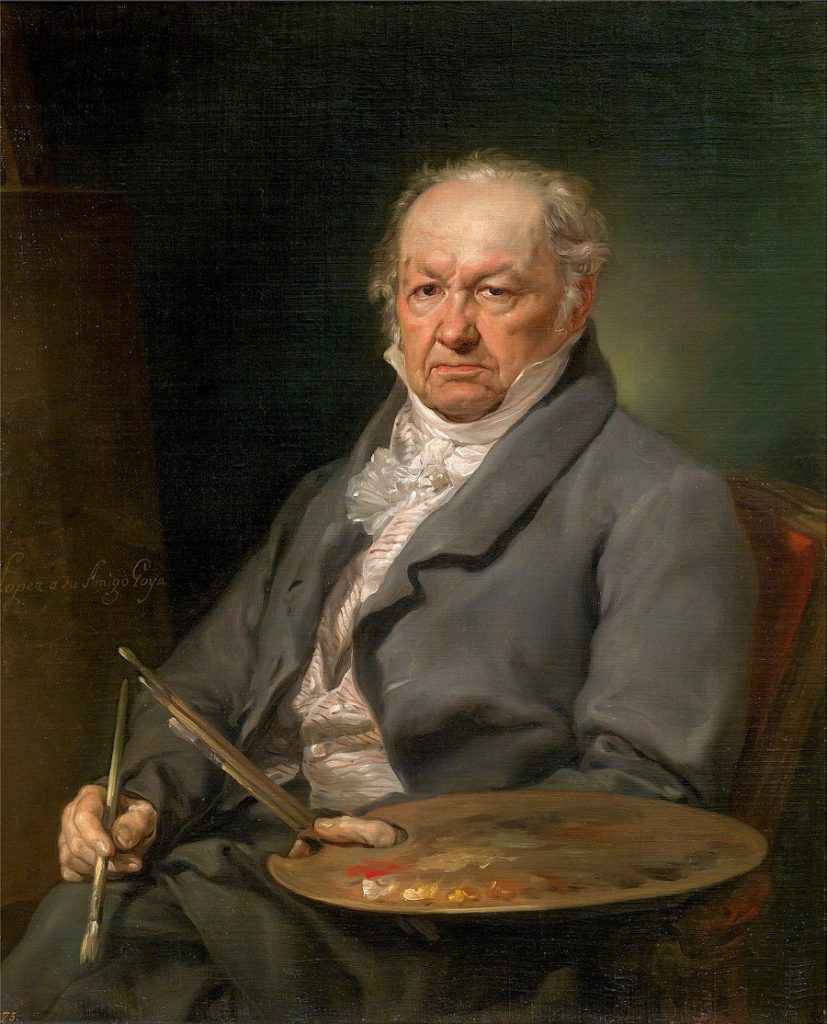
Vicente López Portaña, The Painter Francisco de Goya, 1826, Prado Museum, Madrid, Spain.
At first, the tapestry cartoons were commissioned for Charles III of Spain and then later for Charles IV of Spain. Their purpose was to hang in the San Lorenzo de El Escorial and El Pardo palaces in Spain. Simply put, a tapestry cartoon is a large work of art for tapestry weavers to copy during its creation. Most of the time, the cartoon for a tapestry is more famous than the actual tapestry. That is exactly what happened with most of Goya’s cartoons, mainly due to the medium he used, canvas.
When Goya was asked to create tapestry cartoons, he used that opportunity to showcase his artistry, which helped him secure a place in court as a court painter. The 63 cartoons can be divided into seven different series. Here is a full list of Goya’s seven series of tapestry cartoons.
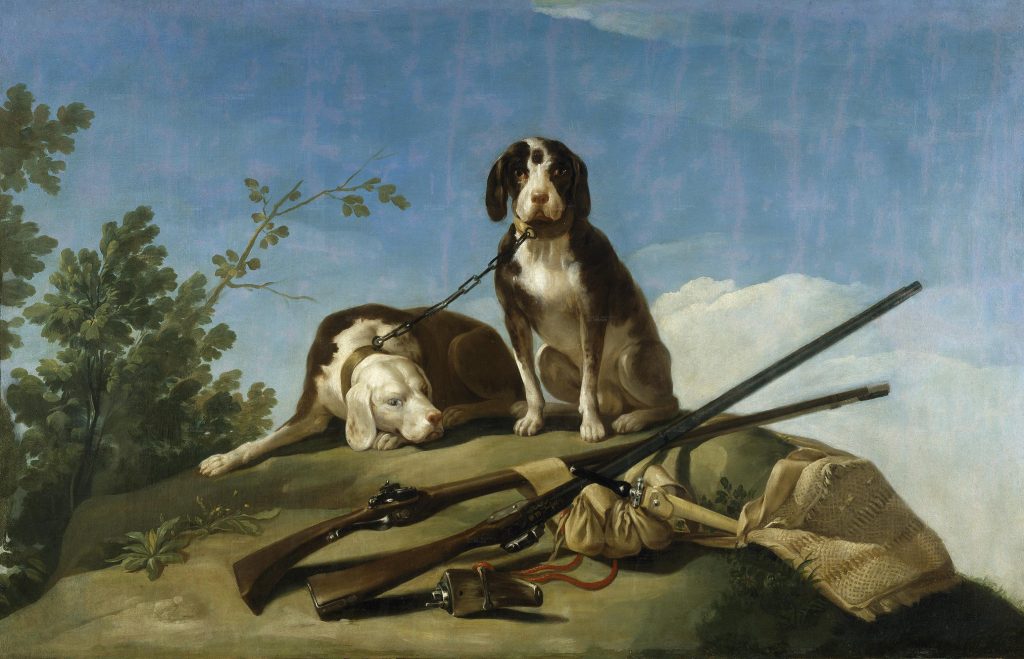
Francisco de Goya, Dogs on a Leash, 1775, Prado Museum, Madrid, Spain. Wikimedia Commons (public domain).
When Goya was commissioned to create his first series of tapestry cartoons in 1775, the cartoons were already in production. The series was based on fellow painter Bayeu y Subias‘ ideas. The seven tapestries were commissioned for the dining room of the Prince and Princess of Asturias at El Escorial.
The subject of the first series was hunting–a subject Goya was quite fond of. In the series, images of hunting dogs, shotguns, and the wilderness hunting grounds were magically displayed. Some of the hunting grounds depicted in the first series included Madrid, the Guadarrama mountains, and El Escorial.
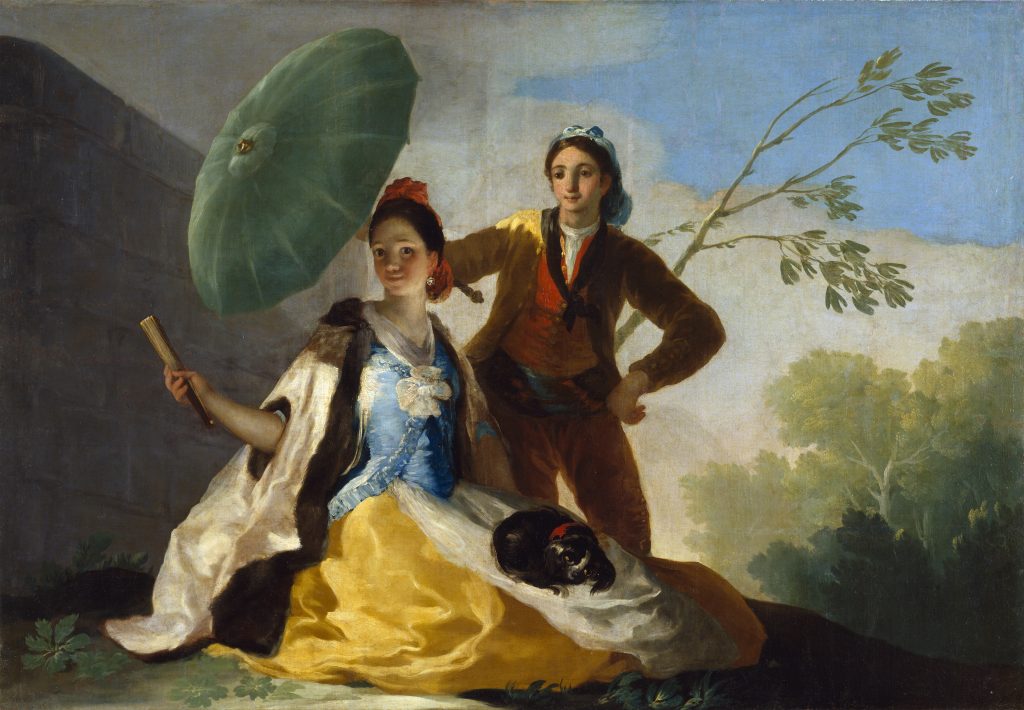
Francisco de Goya, The Parasol, 1777, Prado Museum, Madrid, Spain. Wikimedia Commons (public domain).
Now that Goya had proven his mastery through the first series of tapestry cartoons, the Prince and Princess of Asturias (who later become King Charles IV and Queen Maria Luisa de Parma) commissioned another set. From 1776 to 1778, he painted cartoons for their dining room at the El Pardo palace.
The Prince and Princess wanted the tapestries to depict scenes from everyday life in Madrid. Therefore, Goya painted two famous scenes, Dance on the Banks of the Manzanares and The Parasol. According to the Prado Museum’s website, “These scenes were born of his own imagination, with masterfully characterized popular types and amusing stories filled with satirical and moralizing content that clearly reflects the popular current favored by the Enlightenment.” During this time in Goya’s life, his wife was having their second child, and his happiness is reflected in his work.
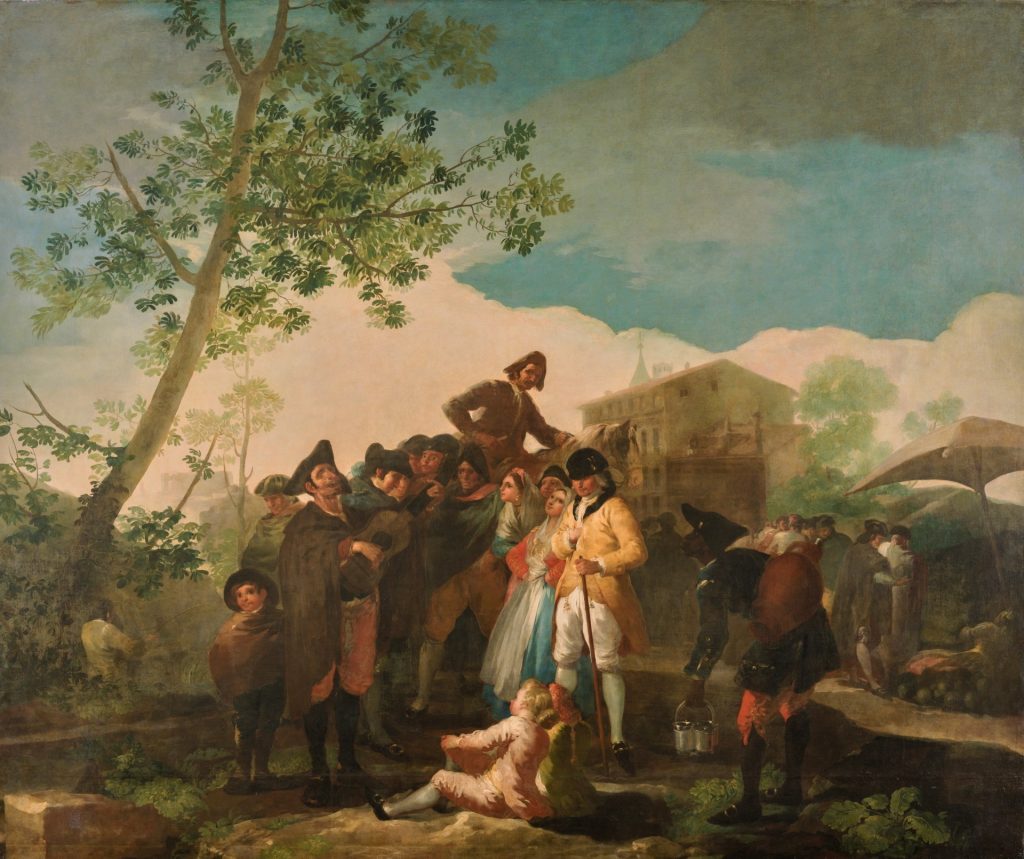
Francisco de Goya, The Blind Guitarist, 1778-1779, Prado Museum, Madrid, Spain. Wikimedia Commons (public domain).
Next, the Prince and Princess of Asturias wanted a set of tapestries for their bedroom at El Pardo. Between 1778 and 1780, Goya painted cartoons with scenes such as The Blind Guitarist. This painting shows a story of a blind singer who travels around sharing tragic news. Interestingly, Goya portrays the onlookers as full of emotions, mainly fascination rather than sorrow. This tapestry was the first presented in the entrance to the Prince and Princess of Asturias’ bedroom at El Pardo.
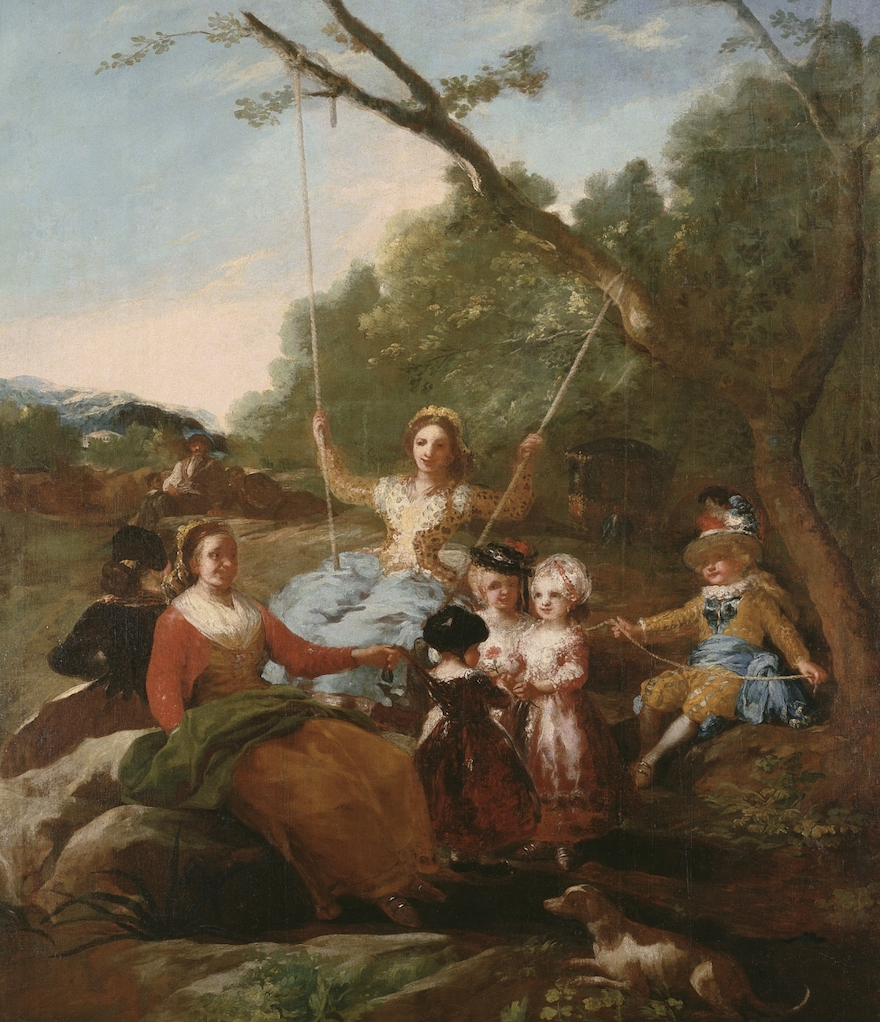
Francisco de Goya, The Swing, 1779, Prado Museum, Madrid, Spain. Wikimedia Commons (public domain). Detail.
After Goya had finished the third series of tapestry cartoons in 1779, he immediately began his fourth series that same year. In this series of tapestries, Goya paints a work called The Swing. Now, Goya’s Swing should not be confused with Jean-Honoré Fragonard’s The Swing; although they are similar in composition, Goya’s work depicts four children and three women enjoying a day in the countryside.
Again, this tapestry cartoon was made for the Prince and Princess of Asturias’ bedroom at El Pardo. But what sets it apart from other works is its counterpart, The Washerwomen.
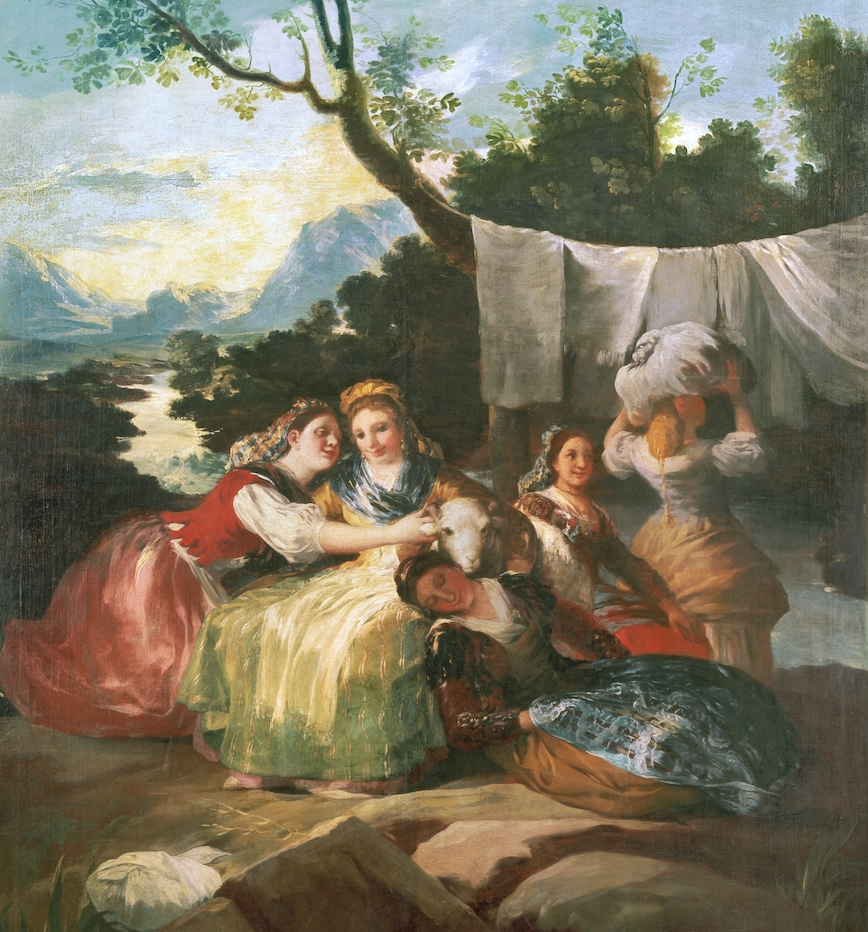
Francisco de Goya, The Washerwomen, 1779, Prado Museum, Madrid, Spain. Wikimedia Commons (public domain). Detail.
Goya created The Swing and The Washerwomen as a pair. Their purpose was to counterbalance the male presence in two other works in the fourth series. The Washerwomen cartoon deserves a feature in this article due to the masterful display of its naturalistic landscape. The Prado Museum claims Goya created the most beautiful landscape in The Washerwoman out of all his tapestry cartoons!
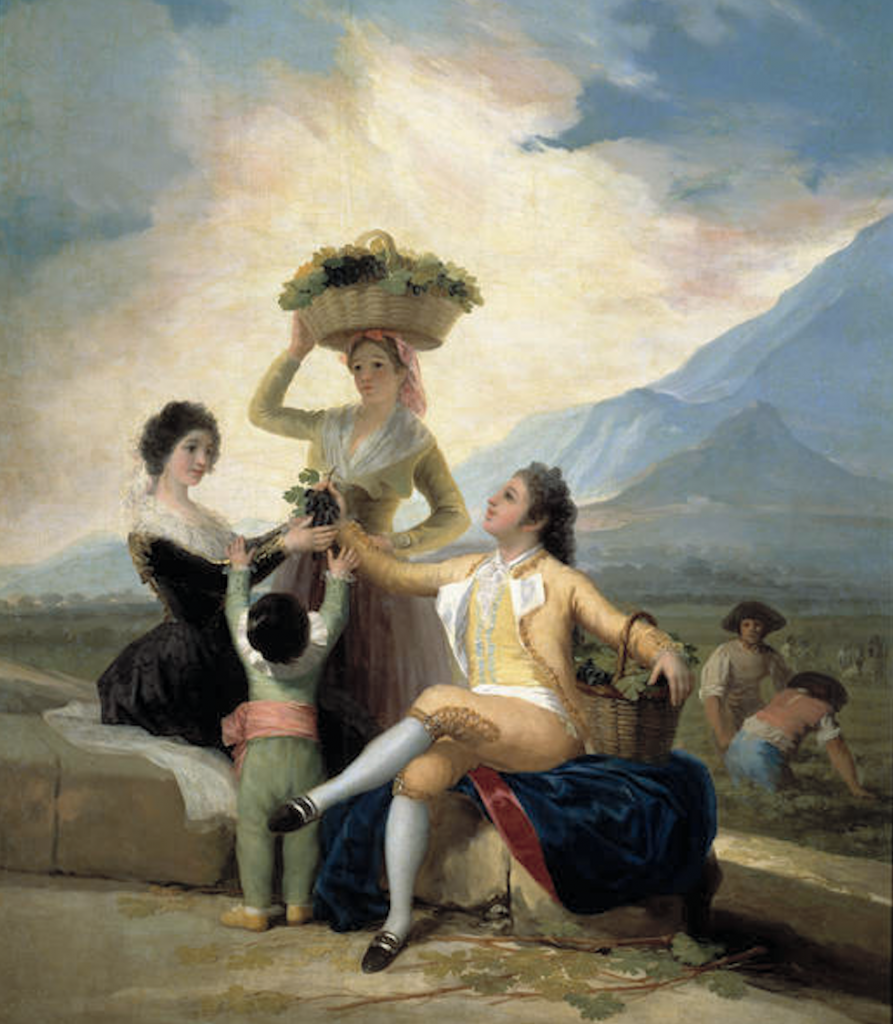
Francisco de Goya, The Grape Harvest or Autumn, 1786-1787, Prado Museum, Madrid, Spain. Wikimedia Commons (public domain). Detail.
Later on, Goya created his fifth series of tapestry cartoons. They were commissioned solely for the Prince of Asturias’ dining room at El Pardo. The Grape Harvest or Autumn is an emblematic example from this series due to its traditional iconography and it is perhaps Goya’s best-known composition from his cartoons.
In the cartoon, the yellow clothes symbolize autumn. Four figures in the painting are present in a pyramidal stance embodying classical art compositions. However, the woman holding a grape basket on her head is the most important person since she is a classical allegory of the goddess Ceres.
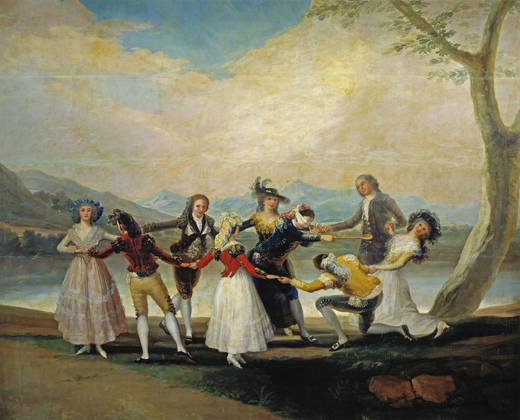
Francisco de Goya, Blind Man’s Buff, 1788, Prado Museum, Madrid, Spain. Wikimedia Commons (public domain). Detail.
For Goya’s sixth series, the tapestry cartoons were made for the Infanta’s bedroom at El Pardo. This particular cartoon, Blind Man’s Buff, shows a group of children, wearing a mix of majos and majas clothing styles, playing a popular game of the eighteenth century with two other figures wearing French style clothing. Since the tapestry was for the Infanta’s bedroom, it is unsurprising that Goya would choose such a friendly subject.
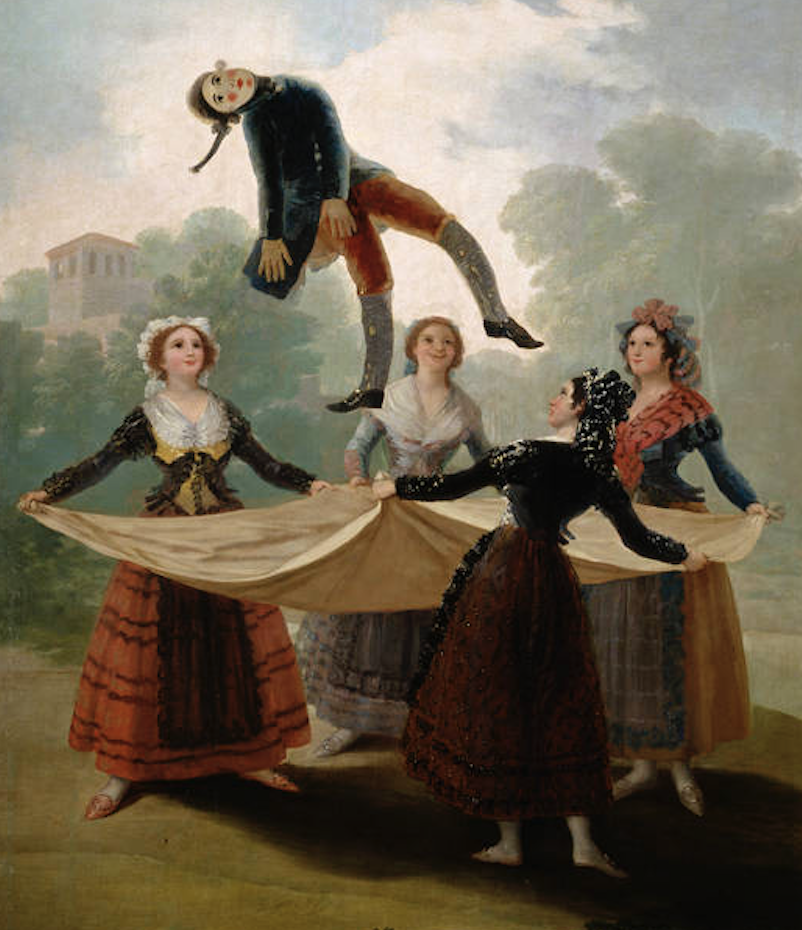
Francisco de Goya, The Straw Manikin, 1791-1792, Prado Museum, Madrid, Spain. Wikimedia Commons (public domain). Detail.
Goya’s seventh series of tapestry cartoons was his last. One of the most famous works from his final series was The Straw Manikin, made between 1791-1792. This tapestry cartoon illustrates four women tossing a doll in the air using a blanket. According to the Prado Museum’s website, the painting is an allegory of women’s domination over men as the women jokingly smile. It was made for Carlos IV’s office in El Escorial. In this final work, Goya’s characteristics shine through his use of softer colors and contrasting light.
In conclusion, most of Goya’s tapestry cartoons remain in Spain at the Prado Museum. His cartoons are still heavily studied today and are regarded as masterpieces. Many scholars agree that Goya was the last known Old Master of Europe and one of the first modern artists.
DailyArt Magazine needs your support. Every contribution, however big or small, is very valuable for our future. Thanks to it, we will be able to sustain and grow the Magazine. Thank you for your help!